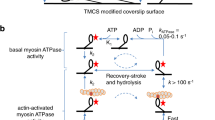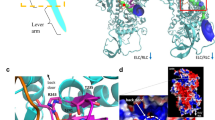Abstract
AN analysis of the reaction mechanism of ATP hydrolysis may elucidate how ATP provides energy for muscle contraction. Kinetic studies of the mechanism of ATP hydrolysis catalysed by myosin and its proteolytic subfragments1,2, revealed at least two intermediates before the rate limiting step: (1) enzyme-bound ATP (M*ATP) and (2) an intermediate (M*ADP·Pi) that yields ADP and Pi when a quenching reagent such as HClO4 is added. Trentham et al.2 proposed that the rate limiting step is the transition from M*ADP·Pi to the Michaelis product complex M·ADP·Pi. That M*ADP·Pi is distinct from the Michaelis product complex is supported by observations made using techniques which include spin labelling3, difference ultraviolet absorption spectroscopy4, extrinsic probe fluorescence5 and intrinsic myosin fluorescence6. Each method shows that the conformation of myosin during ATP hydrolysis differs from the conformation induced by the binding of ADP and Pi. This conclusion is supported further by the observation that the free energy change for the reversible reaction M*ATP  M*ADP·Pi is only −1.3 kcalories per mol (ref. 7). Although comparable in energy with M*ATP, M*ADP·Pi nevertheless seems to be closely related to products because it decays to ADP and Pi when exposed to a quenching reagent. Although this decay to ADP and Pi has been widely interpreted as indicating that ATP is already cleaved in M*ADP·Pi, it could alternatively be interpreted in terms of an uncleaved but labile reaction intermediate.
M*ADP·Pi is only −1.3 kcalories per mol (ref. 7). Although comparable in energy with M*ATP, M*ADP·Pi nevertheless seems to be closely related to products because it decays to ADP and Pi when exposed to a quenching reagent. Although this decay to ADP and Pi has been widely interpreted as indicating that ATP is already cleaved in M*ADP·Pi, it could alternatively be interpreted in terms of an uncleaved but labile reaction intermediate.
This is a preview of subscription content, access via your institution
Access options
Subscribe to this journal
Receive 51 print issues and online access
$199.00 per year
only $3.90 per issue
Buy this article
- Purchase on Springer Link
- Instant access to full article PDF
Prices may be subject to local taxes which are calculated during checkout
Similar content being viewed by others
References
Lymn, R. W., and Taylor, E. W., Biochemistry, 9, 2975–2983 (1970).
Trentham, D. R., Bardsley, R. G., Eccleston, J. F., and Weeds, A. G., Biochem. J., 126, 635–644 (1972).
Seidel, F. C., and Gergely, J., Biochem. biophys. Res. Commun., 44, 826–830 (1971).
Morita, F., J. Biol. Chem., 242, 4501–4506 (1967).
Cheung, H. C., Biochim. biophys. Acta, 194, 478–485 (1969).
Werber, M. M., Szent-Gyoergyi, A. G., and Fasman, G. D., Biochemistry, 11, 2872–2883 (1972).
Bagshaw, C. R., and Trentham, D. R., Biochem. J., 133, 323–328 (1973).
Levy, H., and Koshland, D. E., J. biol.Chem., 234, 1102–1107 (1958).
Sartorelli, L., Fromm, H. J., Benson, R. W., and Boyer, P. D., Biochemistry, 5, 2877–2884 (1966).
Dempsey, M. E., and Boyer, P. D., J. biol Chem., 236, PC6–7 (1961).
Korman, E. F., and McLick, J., Proc. natn. Acad. Sci. USA, 67, 1130–1136 (1970).
Korman, E. F., and McLick, J., Bioenergetics, 3, 147–158 (1972).
Korman, E. F., and McLick, J., Bioorg. Chem., 2, 179–190 (1973).
Young, J. H., Korman, E. F., and McLick, J., Bioorg. Chem. 3, 1–15 (1974).
Yount, R. G., and Koshland, D. E., J. biol. Chem., 238, 1708–1713 (1963).
Swanson, J. R., and Yount, R. G., Biochem. Z., 345, 395–409 (1966).
Mandelkow, E., and Mandelkow, E., FEBS Lett., 33, 161–166 (1973).
Lymn, R. W., and Taylor, E. W., Biochemistry, 10, 4617–4624 (1971).
Huxley, H. E., Science, 164, 1356–1367 (1969).
Eisenberg, E., Dobkin, L., and Kielley, W. W., Proc. natn. Acad. Sci. USA, 69, 667–671 (1972).
Huxley, A. F., and Simmonds, R. M., Nature, 233, 533–538 (1971).
Julian, F. J., Sollins, K. R., and Sollins, M. R., Cold Spring Harbor Symp. quant. Biol., 37, 685 (1972).
Weltman, J. K., and Dowben, R. M., Proc. natn. Acad. Sci. USA, 70, 3230–3234. (1973).
Author information
Authors and Affiliations
Rights and permissions
About this article
Cite this article
YOUNG, J., MCLICK, J. & KORMAN, E. Pseudorotation mechanism of ATP hydrolysis in muscle contraction. Nature 249, 474–476 (1974). https://doi.org/10.1038/249474a0
Received:
Revised:
Issue Date:
DOI: https://doi.org/10.1038/249474a0
Comments
By submitting a comment you agree to abide by our Terms and Community Guidelines. If you find something abusive or that does not comply with our terms or guidelines please flag it as inappropriate.



